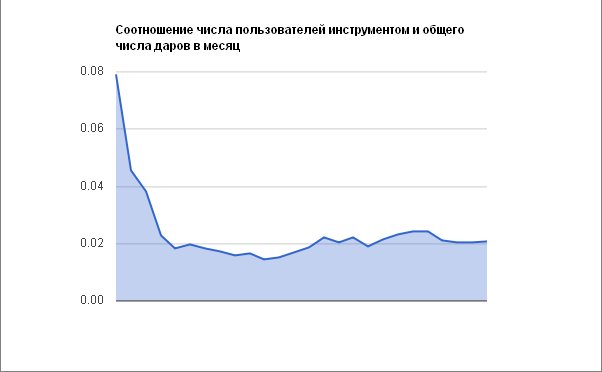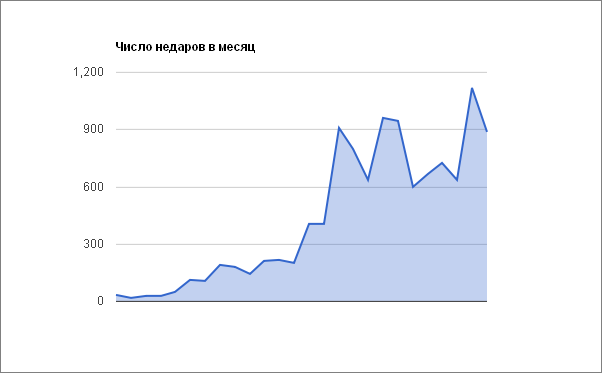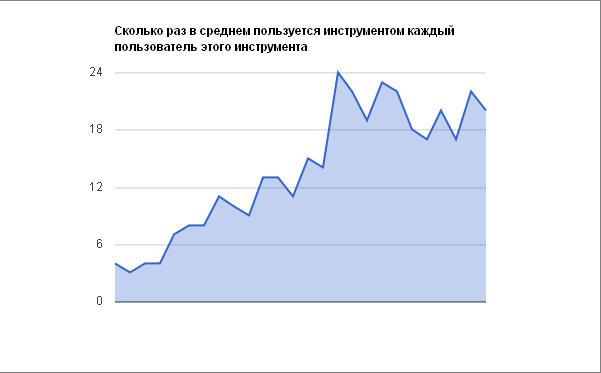A small study on the mechanics of self-organization of online communities
One of the most important principles of our donor community, darudar.org , is the principle of self-organization . The idea of this principle is to distribute the burden of community management among the maximum number of its participants, thus reducing the costs of management to almost zero.
The principle of self-organization is implemented in practice with the help of “disapproval buttons” and a code of conduct governing the use of these buttons. One of these buttons is the “this is not a gift” button, which should be clicked on by each member of the community who sees that a published gift is something that should not be given in our community. If 10 different people click on such a button in some kind of gift, then it will automatically be counted "for nothing".
We had a hypothesis that as the community grows (and, accordingly, as the number of gifts published grows) more and more people will understand what this button is for and how to use it. Accordingly, an increasing percentage of the community will participate in this area of self-organization, and the community will thus unknowingly seek to distribute the load among the maximum number of its members.
')
To test our hypothesis, we carried out numerical statistical measurements for two years of community life, from October 2008 to November 2010. And we came to unexpected conclusions.
Below is a graph of the growth of monthly gifts posted on the site.

And here is a graph of the number of people who at least once click on the “this is not a gift” button.

As you can see, the trends of both graphs almost coincide. Those. the more gifts, the more people are involved in keeping them in order. Let us see, however, how many people are recruited to support self-organization in this area of community life (to click on the “this is not a gift” button).

It turns out that only about 0.02 people are involved to control one gift (this means that one person controls 50 gifts). Moreover, this figure is very constant, although it would be more logical to assume (as we assumed at first) that with the growth of the community, the relative number of people participating in control should increase, and the number of gifts controlled by one person will decrease accordingly. With a stretch, you can see a slight decrease in load, seeing in the graph the transition from an average minimum point of 0.016 to an average maximum of 0.021 people per gift (from 62 to 48 gifts per person). Although it is more appropriate to talk about oscillation around point 0.2.
We made an even more unexpected observation, looking at the results of the works of people pressing the “this is not a gift” button. Let us look at the dynamics of the resulting, due to their joint efforts, non-products. Again, it would be logical to assume that the number of nedars should be directly proportional to the number of gifts and repeat the contours of the chart of the dynamics of gifts. But it turns out it is not.

At a certain point in time (at the beginning of 2010) we see that the number of non-products makes a disproportionate jump and seems to double. Let us verify this first impression by a graph of the ratio of the number of nodals in relation to the number of gifts.

So it is, it looks as if the community existed for a long time (about a year) a certain rate of 0.65% “non-products”, and then rather abruptly it was replaced by another norm of 1.45%, i.e. more than doubled. But at the same time, the number of people involved, if increased, is insignificant, less than one and a half times. What is the matter?
It turns out that those who use the “it’s not for nothing” button begin to use it more and more intensively over time.

If during the year up to the moment of the jump, everyone who at least once pressed the “this is not a gift” button, on average did it 10 times a month, then after the jump the next year, he begins to do it an average of 20 times. Those. twice as often.
From all of the above, it is possible to draw several interesting conclusions, which could not have been supposed at the very beginning.
The community in some elusive way can produce its own permissible norms (what should be given and what should not be given). More precisely, people somehow implicitly “agree” on the permissible level of “noise” (doubtful gifts), preferring to cut off only the established, agreed part of it. Moreover, each new level is not established gradually, following smoothly the general noise level, but abruptly, as if allowing the “noise” to grow in some established limits, during the transition of which there is a need to establish a new fixed level.
To maintain a higher level of order, the community prefers not so much to recruit additional human resources (although this also happens, but to a lesser extent) than to develop the resources already used. In other words, it can be expressed like this. People prefer to privately specialize in their actions. The action of pushing the “this is not a gift” button is not a random simple action available to everyone, but a peculiar skill that can be improved and enhanced. This action is assigned to itself by some part of the community as a peculiar role that this part of the community begins to play. Thus increasing the load for each participant in self-organization, rather than spraying it to the maximum between all.
Here you can make the following reservation. We are talking about reducing the costs of management, but we do not specify what these costs are. But the costs are calculated not only by pressing the button, but above all by the speed of deciding on this push (the competence of the participant), as well as by the confidence that your action is correct and has important consequences (moral costs). And it can be assumed that increasing the competence and morality of individual participants sometimes plays a large role in reducing collective costs, rather than using the time of participants who are less prepared for this kind of occupation. Those. It is “cheaper” to train a certain group of specialists than to use the work of a large army of non-professionals.
The principle of self-organization is implemented in practice with the help of “disapproval buttons” and a code of conduct governing the use of these buttons. One of these buttons is the “this is not a gift” button, which should be clicked on by each member of the community who sees that a published gift is something that should not be given in our community. If 10 different people click on such a button in some kind of gift, then it will automatically be counted "for nothing".
We had a hypothesis that as the community grows (and, accordingly, as the number of gifts published grows) more and more people will understand what this button is for and how to use it. Accordingly, an increasing percentage of the community will participate in this area of self-organization, and the community will thus unknowingly seek to distribute the load among the maximum number of its members.
')
To test our hypothesis, we carried out numerical statistical measurements for two years of community life, from October 2008 to November 2010. And we came to unexpected conclusions.
Below is a graph of the growth of monthly gifts posted on the site.

And here is a graph of the number of people who at least once click on the “this is not a gift” button.

As you can see, the trends of both graphs almost coincide. Those. the more gifts, the more people are involved in keeping them in order. Let us see, however, how many people are recruited to support self-organization in this area of community life (to click on the “this is not a gift” button).

It turns out that only about 0.02 people are involved to control one gift (this means that one person controls 50 gifts). Moreover, this figure is very constant, although it would be more logical to assume (as we assumed at first) that with the growth of the community, the relative number of people participating in control should increase, and the number of gifts controlled by one person will decrease accordingly. With a stretch, you can see a slight decrease in load, seeing in the graph the transition from an average minimum point of 0.016 to an average maximum of 0.021 people per gift (from 62 to 48 gifts per person). Although it is more appropriate to talk about oscillation around point 0.2.
We made an even more unexpected observation, looking at the results of the works of people pressing the “this is not a gift” button. Let us look at the dynamics of the resulting, due to their joint efforts, non-products. Again, it would be logical to assume that the number of nedars should be directly proportional to the number of gifts and repeat the contours of the chart of the dynamics of gifts. But it turns out it is not.

At a certain point in time (at the beginning of 2010) we see that the number of non-products makes a disproportionate jump and seems to double. Let us verify this first impression by a graph of the ratio of the number of nodals in relation to the number of gifts.

So it is, it looks as if the community existed for a long time (about a year) a certain rate of 0.65% “non-products”, and then rather abruptly it was replaced by another norm of 1.45%, i.e. more than doubled. But at the same time, the number of people involved, if increased, is insignificant, less than one and a half times. What is the matter?
It turns out that those who use the “it’s not for nothing” button begin to use it more and more intensively over time.

If during the year up to the moment of the jump, everyone who at least once pressed the “this is not a gift” button, on average did it 10 times a month, then after the jump the next year, he begins to do it an average of 20 times. Those. twice as often.
From all of the above, it is possible to draw several interesting conclusions, which could not have been supposed at the very beginning.
Conclusion number 1
The community in some elusive way can produce its own permissible norms (what should be given and what should not be given). More precisely, people somehow implicitly “agree” on the permissible level of “noise” (doubtful gifts), preferring to cut off only the established, agreed part of it. Moreover, each new level is not established gradually, following smoothly the general noise level, but abruptly, as if allowing the “noise” to grow in some established limits, during the transition of which there is a need to establish a new fixed level.
Conclusion number 2
To maintain a higher level of order, the community prefers not so much to recruit additional human resources (although this also happens, but to a lesser extent) than to develop the resources already used. In other words, it can be expressed like this. People prefer to privately specialize in their actions. The action of pushing the “this is not a gift” button is not a random simple action available to everyone, but a peculiar skill that can be improved and enhanced. This action is assigned to itself by some part of the community as a peculiar role that this part of the community begins to play. Thus increasing the load for each participant in self-organization, rather than spraying it to the maximum between all.
Here you can make the following reservation. We are talking about reducing the costs of management, but we do not specify what these costs are. But the costs are calculated not only by pressing the button, but above all by the speed of deciding on this push (the competence of the participant), as well as by the confidence that your action is correct and has important consequences (moral costs). And it can be assumed that increasing the competence and morality of individual participants sometimes plays a large role in reducing collective costs, rather than using the time of participants who are less prepared for this kind of occupation. Those. It is “cheaper” to train a certain group of specialists than to use the work of a large army of non-professionals.
Source: https://habr.com/ru/post/146816/
All Articles